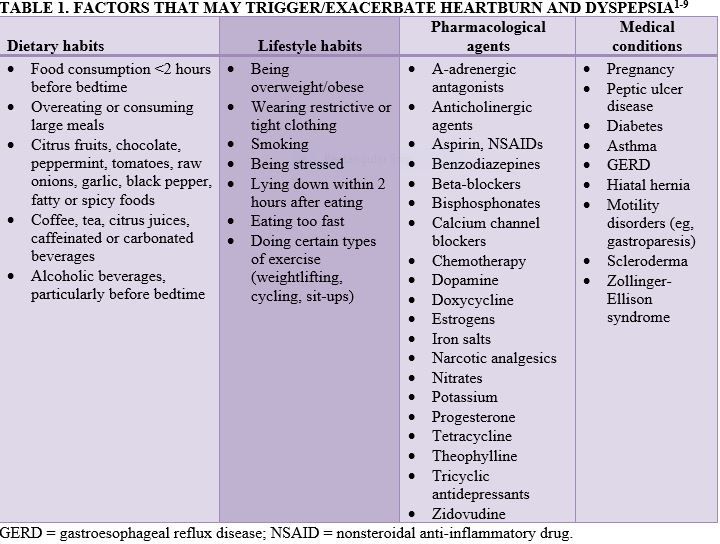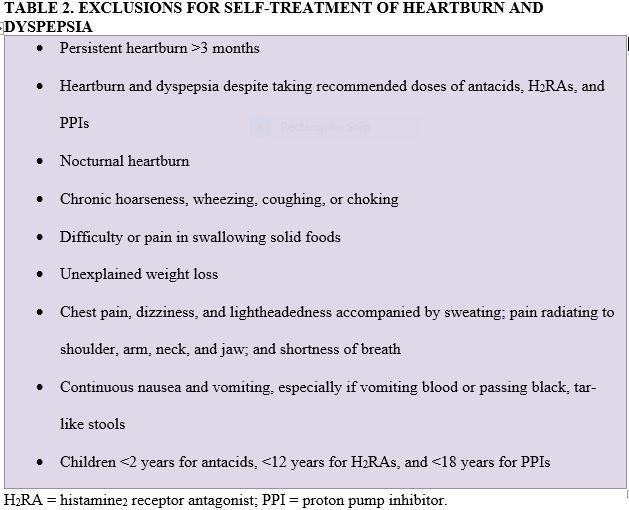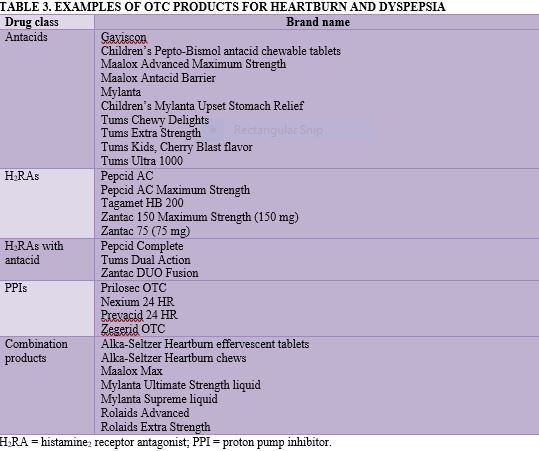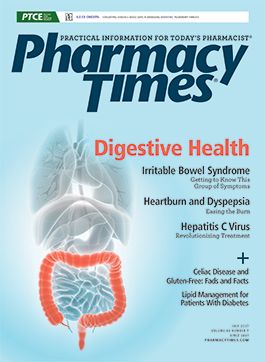Publication
Article
Pharmacy Times
Heartburn and Dyspepsia: Easing the Burn
Author(s):
Pharmacists can be instrumental in identifying patients at increased risk for developing heartburn and dyspepsia because of certain medications, medical conditions, or lifestyle habits.
For anyone experiencing the discomfort associated with heartburn and dyspepsia, finding rapid relief is a top priority. Heartburn and dyspepsia are common gastrointestinal (GI) complaints that, if left unresolved, may negatively affect an individual’s overall quality of life and restrict or limit activities or ingestion of certain foods.1,2
Because many patients elect to self-treat mild to moderate cases of heartburn and dyspepsia, pharmacists are likely to encounter patients seeking advice on the various nonprescription products available for the prevention and treatment of both conditions. Pharmacists also are instrumental in identifying patients at increased risk for developing heartburn and dyspepsia because of certain medications, medical conditions, or lifestyle habits.
Heartburn, or pyrosis, is characterized as a burning sensation arising from the substernal area and moving toward the neck or throat.2 There are 2 main types: postprandial heartburn occurs within 2 hours after a meal, when bending over, or when lying down, and nocturnal heartburn occurs during sleep and often is responsible for interrupting it.1,2 Dyspepsia is pain that manifests in the gastroduodenal region. Symptoms may include postprandial fullness, epigastric pain, and burning.1-3
Patients may experience both heartburn and dyspepsia. According to the American College of Gastroenterology, an estimated 60 million individuals in the United States experience heartburn at least once a month and more than 15 million experience it daily.1 Before recommending any nonprescription product for heartburn and dyspepsia, pharmacists should ascertain whether self-treatment is appropriate.
Episodes of heartburn that are frequent, persistent, or last longer than 3 months are the most common symptoms of gastroesophageal reflux disease, which can cause long-term complications, such as esophagitis, GI bleeding, Barrett’s esophagus, and esophageal cancer if left untreated.2-4 The American Cancer Society says that chronic heartburn may increase an individual’s risk of throat cancer. Therefore, it is important that individuals with frequent heartburn receive appropriate treatment as soon as possible.5
Patients with heartburn and dyspepsia may present with a painful burning sensation in the chest, just behind the sternum, characteristically within 1 to 4 hours after eating; a sour or bitter taste in the mouth; regurgitation of food; excessive burping; a hoarse, sore throat; coughing or choking (especially while lying down); and frequent interruptions of sleep caused by indigestion.1,2 Factors that may contribute to, or exacerbate episodes of, heartburn and dyspepsia include an individual’s diet and lifestyle, the use of certain pharmacological agents, and certain medical conditions (TABLE 11-9).

OTC PRODUCTS
Self-treatment of heartburn and dyspepsia may include the incorporation of dietary and lifestyle modifications and the use of OTC medications (TABLES 2 and 3). Typically, mild to moderate cases of heartburn and dyspepsia are treated easily with OTC products, including antacids, histamine2 receptor antagonists (H2RAs), proton pump inhibitors (PPIs), and combination products containing H2RAs and an antacid.


Antacids
OTC antacids are indicated for the treatment of mild, infrequent heartburn, sour stomach, and acid indigestion. Antacids exert their pharmacologic action by neutralizing gastric acid to relieve heartburn and dyspepsia and acting as buffering agents in the lower esophagus, gastric lumen, and duodenal bulb.2 OTC antacids may contain various salts, including magnesium (hydroxide,carbonate, and trisilicate), aluminum (phosphate and hydroxide), calcium carbonate, and sodium bicarbonate.
Antacids should be taken at the onset of symptoms, and relief typically is experienced within 5 minutes. Patients taking tetracycline, digoxin, iron supplements, fluoroquinolones, and ketoconazole should not use antacids within 2 hours of ingesting these agents. And those with impaired renal function should be advised not to use antacids containing aluminum and magnesium and should discuss this with their primary health care provider (HCP) before using any antacids.
In general, antacids should not be taken more than 4 times a day or on a regular basis for more than 2 weeks. If symptom relief is not achieved or worsens despite the use of antacids, patients should consult their primary HCP.
H2RAs
OTC H2RAs include cimetidine, ranitidine, and famotidine. All are indicated for the treatment of mild to moderate infrequent, episodic heartburn and for the prevention of heartburn associated with acid indigestion and dyspepsia.2 These agents exert their mechanism of action by decreasing gastric acid secretion, inhibiting the effect of histamine on the H2 receptor of the parietal cell, and decreasing the volume of acid secreted. They should be taken at the onset of symptoms or less than 1 hour before symptoms are experienced. Combination products that contain an H2RA antagonist and an antacid appear to provide faster relief of heartburn. Onset of symptom relief typically occurs 30 to 45 minutes after administration, and dosing should be limited to no more than twice a day. Patients should be advised to consult their primary HCP if symptoms persist or worsen after 2 weeks of self-therapy. The most common adverse effects (AEs) include headache, dizziness, diarrhea, drowsiness, and constipation. Potential drug—drug interactions (DDIs) for cimetidine include theophylline, antidepressants/antianxiety agents, phenytoin, and warfarin.
PPIs
PPIs are indicated for the treatment of frequent heartburn in individuals who have episodes of heartburn for more than 2 days each week.2,10 OTC PPIs include omeprazole, esomeprazole, and lansoprazole. HCPs should advise patients that PPIs are not intended for immediate relief of occasional or acute heartburn episodes.
Patients should take these agents only once a day with a glass of water every morning; they are most effective 30 to 60 minutes before a meal, preferably breakfast, and should be swallowed whole. The duration of self-treatment should be restricted to 14 days and no more frequently than every 4 months. It is imperative that patients be advised to complete the full 14-day course of therapy. The onset of symptom relief may occur 2 to 3 hours after taking the dose, but complete relief may take 1 to 4 days after initiating treatment. If symptoms still occur after completing the course of therapy or recur within 4 months, patients should seek a medical evaluation from their primary HCP. The most common AEs associated with PPIs are comparable to those associated with the use of H2RAs. Examples of potential DDIs include pharmacological agents, such as warfarin, ketoconazole, phenytoin, diazepam, digoxin, methotrexate, tacrolimus, and cilostazol.
CONCLUSIONS
When selecting a nonprescription agent for the self-treatment of heartburn and dyspepsia, patients may consider various factors such as the severity, frequency, and duration of their symptoms; dosage intervals; dose form; potential DDIs; contraindications; and cost. It is imperative that pharmacists ascertain the appropriateness of self-treatment and screen for possible DDIs or contraindications before recommending any of these products.
Individuals with preexisting medical conditions and women who are pregnant or lactating should consult with their primary HCP before using any of these products. Pediatric patients should be referred to their primary HCP for treatment recommendations. To avoid further complications, patients with recurring and persistent episodes of heartburn or those exhibiting atypical or severe symptoms should be referred to their primary HCP for further medical evaluation. If symptoms worsen or show no signs of improvement after 14 days of self-treatment, patients using these OTC products should seek immediate medical care.
During counseling, pharmacists can remind patients about OTC measures that may be advantageous in preventing or diminishing the incidence of heartburn and dyspepsia, such as smoking cessation, weight loss, avoidance of late-night eating, and consumption of large meals.2,4,11 Patients also should be advised to not exercise immediately after eating, to abstain from foods and drinks that may aggravate or contribute to heartburn and dyspepsia, and to avoid lying down within 30 minutes of eating.
References
- GERD. American Gastroenterological Association website. gastro.org/patient-care/conditions-diseases/gerd. Accessed June 1, 2017.
- Whetsel T, Zweber A. Heartburn and dyspepsia. In: Krinsky D, Berardi R, Ferreri S, et al, eds. Handbook of Nonprescription Drugs. 18th ed. Washington, DC: American Pharmacists Association; 2015.
- Talley NJ, Vakil N; Practice Parameters Committee of the American College of Gastroenterology. Management of dyspepsia. American College of Gastroenterology website. gi.org/guideline/management-of-dyspepsia. Accessed June 1, 2017.
- GERD. Medline Plus website. nlm.nih.gov/medlineplus/gerd.html. Accessed June 2, 2017.
- Glynn S. Frequent heartburn increases risk of throat cancer by 78% percent. MedicalNewsToday website. medicalnewstoday.com/articles/260965.php. Published May 24, 2013. Accessed June 2, 2017.
- Acid reflux (GER & GERD) in adults. National Institute of Diabetes and Digestive and Kidney Diseases website. niddk.nih.gov/health-information/digestive-diseases/acid-reflux-ger-gerd-adults#2. Accessed June 1, 2017.
- Causes of heartburn. Zantac website. zantacotc.com/heartburn-causes.html. Accessed June 1, 201
- MacGill M. Acid reflux: causes, symptoms, and treatments. MedicalNewsToday website. medicalnewstoday.com/articles/146619.php. Published January 19, 2017. Accessed June 3, 2017.
- Acid reflux. American College of Gastroenterology website. patients.gi.org/topics/acid-reflux. Accessed June 3, 2017.
- Over-the-counter (OTC) heartburn treatment. FDA website. www.fda.gov/Drugs/ResourcesForYou/Consumers/ucm511944.htm. Updated February 23, 2017. Accessed June 1, 2017.
- Gastroesophageal reflux (GERD). Cleveland Clinic website. my.clevelandclinic.org/health/articles/gastroesophogeal-reflux-disease-gerd. Accessed June 1, 2017.
Ms. Terrie is a clinical pharmacist and medical writer based in Haymarket, Virginia.







